EIGRP Tutorial
In this article we will mention about the EIGRP protocol.
In the past, Enhanced Interior Gateway Routing Protocol (EIGRP) is a Cisco-proprietary routing protocol but from March-2013 Cisco opens up EIGRP as an open standard in order to help companies operate in a multi-vendor environment. EIGRP is a classless routing protocol, meaning that it sends the subnet mask of its interfaces in routing updates, which use a complex metric based on bandwidth and delay.
EIGRP is referred to as a hybrid routing protocol because it has the characteristics of both distance-vector and link-state protocols but now Cisco refers it as an advanced distance vector protocol.
Notice: the term “hybrid” is misleading because EIGRP is not a hybrid between distance vector and link-state routing protocols. It is a distance vector routing protocol with enhanced features.
EIGRP is a powerful routing protocol and it is really standout from its ancestor IGRP. The main features are listed below:
+ Support VLSM and discontiguous networks
+ Use Reliable Transport Protocol (RTP) to delivery and reception of EIGRP packets
+ Use the best path selection Diffusing Update Algorithm (DUAL), guaranteeing loop-free paths and backup paths throughout the routing domain
+ Discover neighboring devices using periodic Hello messages to discover and monitor connection status with its neighbors
+ Exchange the full routing table at startup and send partial* triggered updates thereafter (not full updates like distance-vector protocols) and the triggered updates are only sent to routers that need the information. This behavior is different from the link-state protocol in which an update will be sent to all the link-state routers within that area. For example, EIGRP will send updates when a new link comes up or a link becoming unavailable
+ Supports multiple protocols: EIGRP can exchange routes for IPv4, IPv6, AppleTalk and IPX/SPX networks
+ Load balancing: EIGRP supports unequal metric load balancing, which allows administrators to better distribute traffic flow in their networks.
* Notice: The term “partial” means that the update only includes information about the route changes.
EIGRP use metrics composed of bandwidth, delay, reliability, and load. By default, EIGRP uses only bandwidth and delay.
EIGRP use five types of packets to communicate:
+ Hello: used to identify neighbors. They are sent as periodic multicasts
+ Update: used to advertise routes, only sent as multicasts when something is changed
+ Ack: acknowledges receipt of an update. In fact, Ack is Hello packet without data. It is always unicast and uses UDP.
+ Query: used to find alternate paths when all paths to a destination have failed
+ Reply: is sent in response to query packets to instruct the originator not to recompute the route because feasible successors exist. Reply packets are always unicast to the originator of the query
EIGRP sends every Query and Reply message using RTP, so every message is acknowledged using an EIGRP ACK message.
EIGRP Route Discovery
Suppose that our network has 2 routers and they are configured to use EIGRP. Let’s see what will happen when they are turned on.
Firstly, the router will try to establish a neighboring relationships by sending “Hello” packets to others running EIGRP. The destination IP address is 224.0.0.10 which is the multicast address of EIGRP. By this way, other routers running EIGRP will receive and proceed these multicast packets. These packets are sent over TCP.
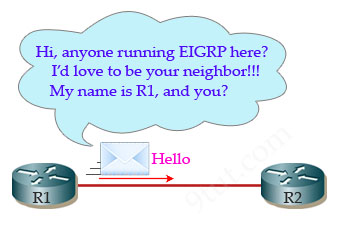
After hearing “Hello” from R1, R2 will respond with another “Hello” packet.
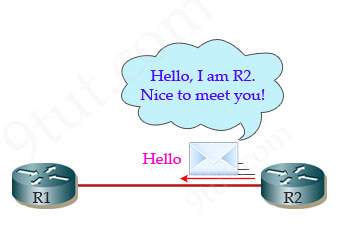
R2 will also send its routing table to R1 by “Update” packets. Remember that R2 will send its complete routing table for the first time.
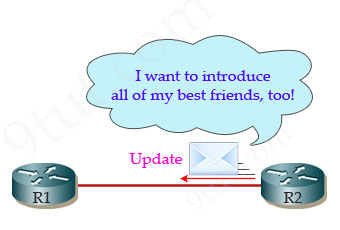
R1 confirms it has received the Update packet by an “ACK” message.
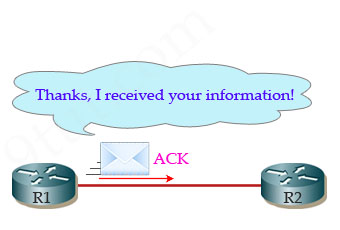
R1 will also send to R2 all of its routing table for the first time
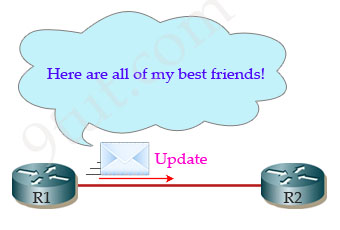
R2 sends a message saying it has received R1’s routing table.
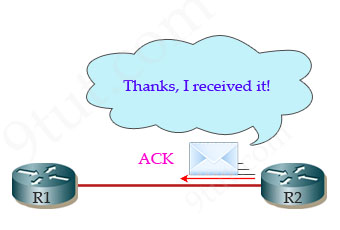
Now both R1 & R2 learn all the paths of the neighbor and the network is converged. But there are some notices you should know:
+ After the network converged, “Hello” messages will still be sent to indicate that the it is still alive.
+ When something in the network changes, routers will only send partial updates to routers which need that information.
+ Hellos are sent as periodic multicasts and are not acknowledged directly.
+ The first hellos are used to build a list of neighbors; thereafter, hellos indicate that the neighbor is still alive
To become a neighbor, the following conditions must be met:
+ The router must hear a Hello packet from a neighbor.
+ The EIGRP autonomous system must be the same.
+ K-values must be the same.
EIGRP builds and maintains three tables:
+ Neighbor table: lists directly connected routers running EIGRP with which this router has an adjacency
+ Topology table: lists all routes learned from each EIGRP neighbor
+ Routing table: lists all best routes from the EIGRP topology table and other routing processes
Configuring EIGRP
| Router(config)#router eigrp 1 |
Syntax: router eigrp <AS number> Turn on the EIGRP process 1 is the Autonomous System (AS) number. It can be from 1 to 65535. All routers in the same network must use the same AS number. |
| Router(config-router)#network 192.168.1.0 |
Router will turn on EIGRP 1 process on all the interfaces belonging to 192.168.1.0/24 network. |
In the next part we will learn about the Feasible Distance & Administrative Distance of EIGRP



please share ccnp route dumps and lab. Humble requested.
asgharshahhashmi @ gmail . com
Thanks!!!!
thankyou
Hi you recently moved the questions how can i do the questions i wont pass the exam without doing the questions
Hi All,
EIGRP is not in current 2023 CCNA syllabus right? only OSPF?
I took the exam in April and I do not recall having any EIGRP questions, but things could have changed from then.
Can generative AI be used to improve predictive AI algorithms in networking, and how do these two types of AI differ in their applications and potential impact on network operations?”,
“refusal
Where is the EIGRP request type packet?